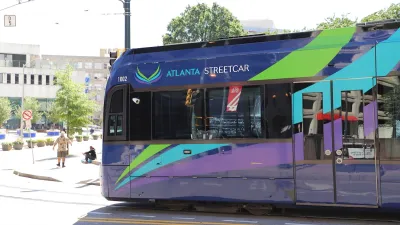Even movies set long ago and far, far away have to be filmed somewhere. With uncanny frequency, many of them, including "The Hunger Games" and "Insurgent," have been filmed in the futuristic/dystopian landscape designed by John Portman in Atlanta.

Having been rebuilt from scratch following the Civil War, Atlanta hit its stride by the 1980s, when it embraced modernist planning and modern architecture like few other American cities had. One of the poster children for urban sprawl, Atlanta built miles of freeways and built downtown towers with scant connections to the streets. Leading this modernist transformation was architect John Portman, whose signature atriums, glass elevators, and glass facades were meant to feel like cities within a city, sealed off from the chaos outside.
While urban planning has moved on from that era, Portman's apparent quest for modernity has made his buildings seem more futuristic than ever, so much so that they are frequently featured in science fiction films. The future often does not look very bright. Recently, post-apocalyptic stories including The Hunger Games: Mockingjay, Insurgent, and Interstellar have all used Portman buildings as backdrops.
Analyzing the role of Portman's work in contemporary cinema, Kristi York Wootten writes in The Atlantic:
"Filmmakers use architecture to represent societies that are forming or collapsing, and conceptual structures are too eccentric to symbolize the collective groups that dominate dystopian storylines. Portman’s work fits on film in part because his design philosophy straddles the modernism and brutalism handed down to his generation from predecessors such as Le Corbusier and Marcel Breuer, who strove to incorporate functionality and community into their buildings."
FULL STORY: How 1980s Atlanta Became the Backdrop for the Future

Alabama: Trump Terminates Settlements for Black Communities Harmed By Raw Sewage
Trump deemed the landmark civil rights agreement “illegal DEI and environmental justice policy.”

Study: Maui’s Plan to Convert Vacation Rentals to Long-Term Housing Could Cause Nearly $1 Billion Economic Loss
The plan would reduce visitor accommodation by 25% resulting in 1,900 jobs lost.

Why Should We Subsidize Public Transportation?
Many public transit agencies face financial stress due to rising costs, declining fare revenue, and declining subsidies. Transit advocates must provide a strong business case for increasing public transit funding.

Wind Energy on the Rise Despite Federal Policy Reversal
The Trump administration is revoking federal support for renewable energy, but demand for new projects continues unabated.

Passengers Flock to Caltrain After Electrification
The new electric trains are running faster and more reliably, leading to strong ridership growth on the Bay Area rail system.

Texas Churches Rally Behind ‘Yes in God’s Back Yard’ Legislation
Religious leaders want the state to reduce zoning regulations to streamline leasing church-owned land to housing developers.
Urban Design for Planners 1: Software Tools
This six-course series explores essential urban design concepts using open source software and equips planners with the tools they need to participate fully in the urban design process.
Planning for Universal Design
Learn the tools for implementing Universal Design in planning regulations.
Caltrans
Smith Gee Studio
Institute for Housing and Urban Development Studies (IHS)
City of Grandview
Harvard GSD Executive Education
Toledo-Lucas County Plan Commissions
Salt Lake City
NYU Wagner Graduate School of Public Service





























